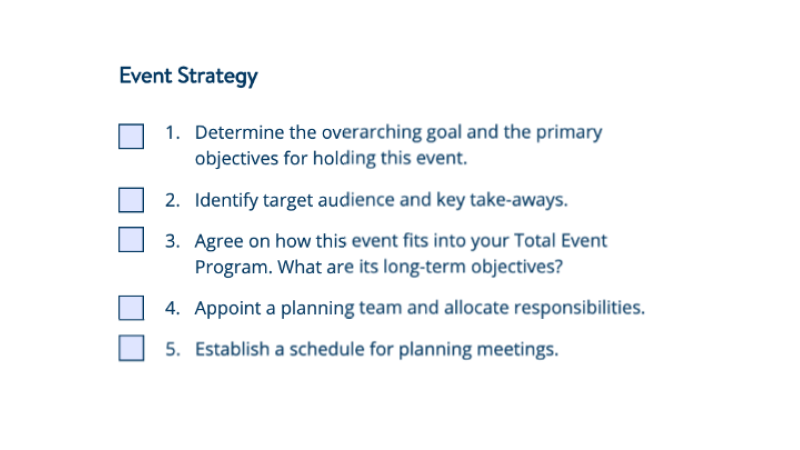Planning an awesome in-person event with hundreds or thousands of attendees? As exciting as that is for your event management team, it comes with a big responsibility—keeping the crowd safe and under control.
No event planner wants injuries, emergencies, or anything dangerous at their event venue. So how do you handle onsite crowd management smoothly? Cvent has organized many large in-person events, and here we have listed some of the best event planning tips so your attendees can have fun without worrying.
But first:
Why Does Crowd Management Matter So Much?
When you get huge groups together in one event venue space, things can get out of hand quickly without proper event planning and crowd management—ever been in a crowd that's pushing and shoving? It's scary.
That's why managing crowds is vital for safe in-person events—it keeps people safe from trampling and injuries. It also makes sure everyone can exit if there's an emergency. Oh, and it prevents your event from being overwhelmed or interrupted—a big plus.
Building Your Crowd Management Plan
This is your game plan to assess risks and prevent any crowd-related messes. When building your plan, you'll want to think about crowd size and resources. Here's what to consider:
- How big will your crowds get during onsite check-in? Ensure you have enough security, medical staff, and ushers.
- What about venue management—what does the event venue layout look like? Map out entrances, exits, and tight spots where people could get jammed up.
- How will you guide people through the event space? Use barricades, signs, ground markers, and staff to steer crowds effectively.
- What's your communication plan? Staff radios, PA announcements, screens—you'll need them.
- How about emergencies? Develop those protocols for medical calls, lost kids, weather, etc., so you're event-ready.
- What are your contingency plans if things get hairy? Identify evacuation routes, shelters, and ways to contact attendees.
Get the idea? Anticipate needs, troubleshoot scenarios, and have crowd management procedures so you can take action quickly if needed.
Quick Tip: Use onsite check-in tools to reduce long queues at registration desks and print badges.
Crowd Control Tips: Keeping Your Cool When Things Get Crowded
When a crowd starts gathering at your event, it's time to implement your crowd management plan. Here's how you can do it and keep your cool:
- Designate specific entry and exit lanes for attendees: Establish dedicated lanes for incoming and outgoing event-goers to prevent unnecessary congestion and reduce the likelihood of confusion or mishaps. Ensure these lanes are adequately supervised and well-identified to ensure a smooth flow of people.
- Install clear signs for directions: Make the navigation of your venue as easy as possible by putting up clear, easily understandable signs. Use different means of communication, like signs, decals on the event venue floor, and on-duty staff members who can help direct the crowd. Consider using different languages and symbols to cater to diverse attendees.
- Identify and address potential congestion points: Be proactive in spotting areas where the crowd may bottleneck, leading to possible congestion. These are your danger zones! Use markers, barricades, or additional staff to redirect attendees away from these spots to promote a continuous flow of movement.
- Redirect traffic from crowded areas: Monitor crowd density at various locations. If one area becomes overly crowded, start directing people to less packed spots before it becomes dangerous.
- Maintain vigilant for signs of distress: Incidents like fainting or other medical needs are common in large gatherings. Keep your medical team alert and ready to attend to such situations swiftly. Implement an efficient communication system so the medical team can be promptly alerted.
- Remind attendees of essential information: Regular reminders about key details like the locations of exits and first aid stations and event rules help keep attendees aware and informed. Use various methods, like announcements, digital signage, and staff reminders, to reinforce these crucial details.
Handling Crowd Medical Emergencies
Even with the most meticulous planning and crowd control strategies, dealing with medical emergencies is often an inevitable part of handling a large gathering. Here's how to manage these situations effectively and efficiently:
- Position trained medical staff throughout the crowd: It is crucial to have your trained medical personnel strategically scattered throughout the venue. By doing so, immediate help is available for any potential medical situation.
- Establish medical stations outside crowded zones: Set up well-stocked and staffed medical stations near high-traffic areas. The placement of these stations should allow for easy visibility and access, ensuring that anyone in need can locate them quickly.
- Allocate specific lanes for emergency responders: Designate and maintain clear pathways through the crowd that allows for quick and unhindered movement of emergency medical responders for speedy medical assistance.
- Appoint liaison staff to communicate with emergency medical services: Assign specific staff members the task of guiding emergency medical services to the location of the incident. These individuals should have excellent communication skills and knowledge of the event's layout, ensuring that the medical personnel get to the location of the emergency swiftly.
- Establish contact with local hospitals in advance: Contact nearby hospitals and inform them about your event. Establishing a connection in a severe emergency requiring immediate hospitalization can speed up the process and ensure timely medical attention.
- Document all incidents: Keep a record of all medical incidents, no matter how minor they seem. This will be helpful for both post-event analysis and any necessary legal or insurance purposes.
- Develop a comprehensive communication system: Establish a reliable, effective communication system for medical emergencies, including walkie-talkies, dedicated phone lines, or an app-based communication system that allows staff to report and respond to incidents quickly.
- Regular announcements and reminders: Remind attendees about the location of medical aid stations and encourage them to seek help if they don't feel well. Use public address systems, digital signboards, and social media to convey these reminders.
Venue Safety: Keeping Things Secure
You want your event to be fun for all, without any security risks. Some ways to keep it safe:
- Implement rigorous checks at entry points: Implement a thorough bag-checking system and use metal detectors to prevent prohibited items from entering the venue. Ensure to have a list of banned items and strictly enforce their adherence. This process can help avoid any potentially harmful situations.
- Deploy security teams and police patrol: Ensure well-trained security teams are visible and actively patrolling the crowd and the event's perimeter. Their mere presence can deter unwanted activities. If possible, arrange for local police to patrol the area to provide an extra layer of security.
- Equip staff with de-escalation skills: Train your staff in techniques to defuse tense situations before they escalate to violence. Providing them with these skills can nip potential altercations in the bud, ensuring the safety and comfort of all attendees.
- Monitor social media for potential threats: In today's digital age, threats can surface on social media platforms before the event. Keep a close eye on social media mentions about your event and look for any suspicious activity or potential threats. This proactive approach can prevent unwelcome surprises.
- Prioritize de-escalation over enforcement: If violent incidents occur, concentrate first on quick de-escalation tactics. Use your trained staff to manage the situation before involving law enforcement. This approach can resolve issues more quickly and with less disruption to the event.
- Maintain detailed incident records: Document all incidents thoroughly, no matter how insignificant they may seem. These records are crucial for further investigations and reviewing and improving your event security plans for future events.
Prepping for Rain or Shine—Weather Prep
- Stay informed: Keep a close eye on weather forecasts. Develop plans to address weather scenarios like storms, excessive heat, wind, lightning, etc.
- Plan for shelter: Determine secure and sturdy shelters where attendees can take cover in case of severe weather conditions. These should be easily accessible and well-marked.
- Prioritize safety: During extreme weather, be ready to suspend outdoor activities. Remember, event safety should always be your top priority.
- Prepare for heat: In case of heat waves, ensure sufficient water supplies to distribute among attendees. Consider setting up cooling stations to help prevent heat-related health issues.
- Emergency messaging: Have a robust emergency communication plan ready to roll out at a moment's notice. Use social media posts, text alerts, in-app notifications, public address systems, and more.
Tying it All Together
There you have it—top strategies for smart crowd management and safe events! It takes work but lets attendees have a fantastic time without disruptions. Just stay flexible, communicate constantly, and keep safety the priority. Here's to your upcoming event that will leave the crowd spellbound!








